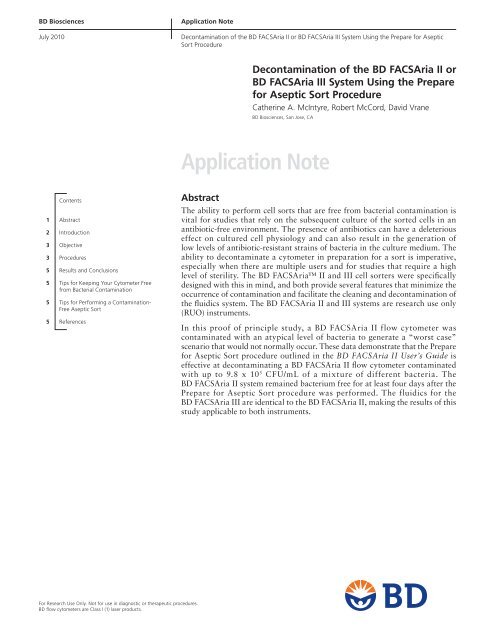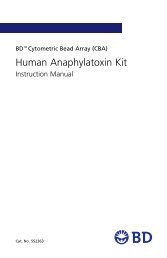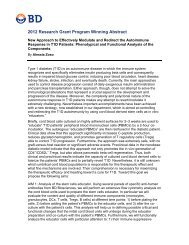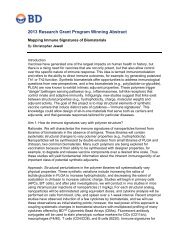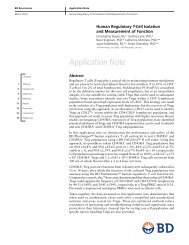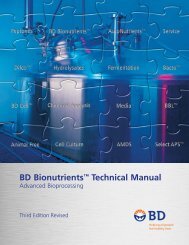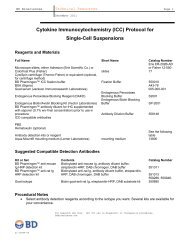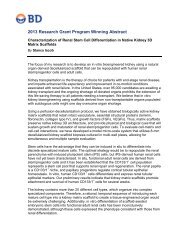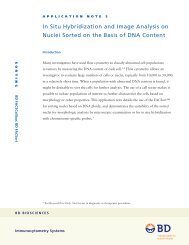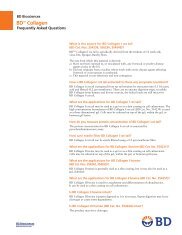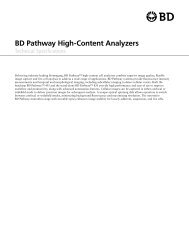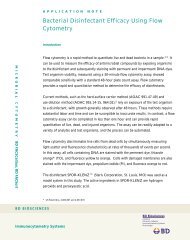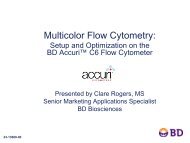Decontamination Of The BD FACSAria II - BD Biosciences
Decontamination Of The BD FACSAria II - BD Biosciences
Decontamination Of The BD FACSAria II - BD Biosciences
Create successful ePaper yourself
Turn your PDF publications into a flip-book with our unique Google optimized e-Paper software.
<strong>BD</strong> <strong>Biosciences</strong><br />
July 2010<br />
Contents<br />
1 Abstract<br />
2 Introduction<br />
3 Objective<br />
3 Procedures<br />
5 Results and Conclusions<br />
5 Tips for Keeping Your Cytometer Free<br />
from Bacterial Contamination<br />
5 Tips for Performing a Contamination-<br />
Free Aseptic Sort<br />
5 References<br />
For Research Use Only. Not for use in diagnostic or therapeutic procedures.<br />
<strong>BD</strong> flow cytometers are Class I (1) laser products.<br />
Application Note<br />
<strong>Decontamination</strong> of the <strong>BD</strong> <strong>FACSAria</strong> <strong>II</strong> or <strong>BD</strong> <strong>FACSAria</strong> <strong>II</strong>I System Using the Prepare for Aseptic<br />
Sort Procedure<br />
<strong>Decontamination</strong> of the <strong>BD</strong> <strong>FACSAria</strong> <strong>II</strong> or<br />
<strong>BD</strong> <strong>FACSAria</strong> <strong>II</strong>I System Using the Prepare<br />
for Aseptic Sort Procedure<br />
Catherine A. McIntyre, Robert McCord, David Vrane<br />
<strong>BD</strong> <strong>Biosciences</strong>, San Jose, CA<br />
Application Note<br />
Abstract<br />
<strong>The</strong> ability to perform cell sorts that are free from bacterial contamination is<br />
vital for studies that rely on the subsequent culture of the sorted cells in an<br />
antibiotic-free environment. <strong>The</strong> presence of antibiotics can have a deleterious<br />
effect on cultured cell physiology and can also result in the generation of<br />
low levels of antibiotic-resistant strains of bacteria in the culture medium. <strong>The</strong><br />
ability to decontaminate a cytometer in preparation for a sort is imperative,<br />
especially when there are multiple users and for studies that require a high<br />
level of sterility. <strong>The</strong> <strong>BD</strong> <strong>FACSAria</strong> <strong>II</strong> and <strong>II</strong>I cell sorters were specifically<br />
designed with this in mind, and both provide several features that minimize the<br />
occurrence of contamination and facilitate the cleaning and decontamination of<br />
the fluidics system. <strong>The</strong> <strong>BD</strong> <strong>FACSAria</strong> <strong>II</strong> and <strong>II</strong>I systems are research use only<br />
(RUO) instruments.<br />
In this proof of principle study, a <strong>BD</strong> <strong>FACSAria</strong> <strong>II</strong> flow cytometer was<br />
contaminated with an atypical level of bacteria to generate a “worst case”<br />
scenario that would not normally occur. <strong>The</strong>se data demonstrate that the Prepare<br />
for Aseptic Sort procedure outlined in the <strong>BD</strong> <strong>FACSAria</strong> <strong>II</strong> User’s Guide is<br />
effective at decontaminating a <strong>BD</strong> <strong>FACSAria</strong> <strong>II</strong> flow cytometer contaminated<br />
with up to 9.8 x 10 5 CFU/mL of a mixture of different bacteria. <strong>The</strong><br />
<strong>BD</strong> <strong>FACSAria</strong> <strong>II</strong> system remained bacterium free for at least four days after the<br />
Prepare for Aseptic Sort procedure was performed. <strong>The</strong> fluidics for the<br />
<strong>BD</strong> <strong>FACSAria</strong> <strong>II</strong>I are identical to the <strong>BD</strong> <strong>FACSAria</strong> <strong>II</strong>, making the results of this<br />
study applicable to both instruments.
<strong>BD</strong> <strong>Biosciences</strong><br />
July 2010<br />
Application Note<br />
<strong>Decontamination</strong> of the <strong>BD</strong> <strong>FACSAria</strong> <strong>II</strong> or <strong>BD</strong> <strong>FACSAria</strong> <strong>II</strong>I System Using the Prepare for Aseptic<br />
Sort Procedure<br />
Introduction<br />
Bacterial contamination of cell products derived by sorting on a flow cytometer<br />
can compromise studies subsequently performed on the sorted cells. Many<br />
laboratories protect their sorted cell products from such contamination by<br />
using antibiotics in the medium for post-sort culture. Antibiotics can have a<br />
deleterious effect on the cells in culture and can lead to the presence of low levels<br />
of antibiotic-resistant bacterial contamination. <strong>The</strong> presence of these antibioticresistant<br />
bacteria might result in a depletion of essential nutrients and factors<br />
required by the cells in culture and the accumulation of bacterial metabolic<br />
waste products. <strong>The</strong>se waste products might have unknown, unwanted, or<br />
toxic effects on cell metabolism or responses.<br />
A cell sorter is often used by several operators (eg, in a flow core lab) for the<br />
analysis and sorting of a variety of samples including, but not limited to, human-<br />
or animal-derived blood products and cultured cells. <strong>The</strong>se samples might be<br />
contaminated with bacteria, viruses, or other pathogens that can potentially<br />
cause contamination of subsequent samples. In addition to samples, a cause of<br />
contamination is insufficient cleaning and maintenance of the cytometer and<br />
the use of fluids that have become contaminated (such as sheath fluid, deionized<br />
[DI] water, bleach, or ethanol).<br />
New fluidics design<br />
<strong>The</strong> <strong>BD</strong> <strong>FACSAria</strong> <strong>II</strong> and <strong>II</strong>I flow cytometers were designed for easy<br />
cleaning and decontamination. When compared to the <strong>BD</strong> <strong>FACSAria</strong>, the<br />
<strong>BD</strong> <strong>FACSAria</strong> <strong>II</strong> and <strong>II</strong>I instruments have a simplified sheath path with a reduced<br />
number of components, decreasing the fluid volume and the surface area available<br />
for contamination. <strong>The</strong> sheath tank is removable and autoclavable. Some of the<br />
tubing is now made from Teflon®, and the new fluidics system requires fewer<br />
valves. Valves are a manifold style (with less dead volume than the original style)<br />
and are very reliable. <strong>The</strong> sheath fluid path has a dedicated fluid line separate<br />
from the cleaning fluid line that is used only during cleaning and shutdown.<br />
Taken together, these new features reduce the opportunity for contamination<br />
and increase the efficacy of the cleaning and decontamination procedures.<br />
Prepare for Aseptic Sort procedure<br />
<strong>The</strong> Prepare for Aseptic Sort wizard in <strong>BD</strong> FACSDiva software has been<br />
designed to lead the <strong>BD</strong> <strong>FACSAria</strong> <strong>II</strong> and <strong>II</strong>I operator through a decontamination<br />
of the fluidics system. When used in this context, the word aseptic does not<br />
imply that cells sorted on the <strong>BD</strong> <strong>FACSAria</strong> <strong>II</strong> or <strong>II</strong>I systems will be free from<br />
all potentially infectious material, but only that this cleaning procedure can<br />
be used prior to sorting and can result in sorted cell suspensions free from<br />
bacterial contamination. When the operator initiates the procedure, the DI<br />
water, umbilical, and cytometer fluid pathways are rinsed, and the sample line<br />
is backflushed, followed by a soak in 10% bleach (0.5% sodium hypochlorite<br />
solution). This is followed by a rinse, backflush, and soak with DI water. Finally,<br />
the system is thoroughly flushed with ethanol to remove any residue. During the<br />
subsequent Fluidics Startup procedure, the umbilical and cytometer pathways<br />
are rinsed and the sample line is backflushed with sheath fluid, preparing the<br />
instrument for setup and sample introduction.<br />
<strong>The</strong> Prepare for Aseptic Sort procedure can be used after a known bacterial<br />
contamination has occurred, immediately prior to an aseptic sort, or as a<br />
routine maintenance procedure to minimize or prevent the occurrence of<br />
bacterial contamination in the cytometer’s fluidics system.<br />
For Research Use Only. Not for use in diagnostic or therapeutic procedures.<br />
<strong>BD</strong> flow cytometers are Class I (1) laser products.
<strong>BD</strong> <strong>Biosciences</strong><br />
July 2010<br />
Application Note<br />
<strong>Decontamination</strong> of the <strong>BD</strong> <strong>FACSAria</strong> <strong>II</strong> or <strong>BD</strong> <strong>FACSAria</strong> <strong>II</strong>I System Using the Prepare for Aseptic<br />
Sort Procedure<br />
Objective<br />
Page 3<br />
<strong>The</strong> objective of this application note is to demonstrate that in this proof of<br />
principle experiment the Prepare for Aseptic Sort procedure can remove high<br />
levels of bacterial contamination from the fluidics system of a <strong>BD</strong> <strong>FACSAria</strong> <strong>II</strong><br />
flow cytometer. <strong>The</strong> fluidics for the <strong>BD</strong> <strong>FACSAria</strong> <strong>II</strong>I are identical to the<br />
<strong>BD</strong> <strong>FACSAria</strong> <strong>II</strong>, making the results of this study applicable to both instruments.<br />
Procedures<br />
Table 1. Materials<br />
Material<br />
<strong>BD</strong> Falcon cell culture flask, 75 cm2 Pseudomonas aeruginosa (Schroeter) Migula<br />
Escherichia coli (Migula) Castellani and Chalmers<br />
Bacillus cereus Frankland and Frankland; deposited as<br />
Bacillus siamensis Siribaed<br />
Staphylococcus epidermidis (Winslow and Winslow) Evans<br />
Deionized (DI) water<br />
Clorox® Bleach Ultra<br />
Ethanol (70% solution, denatured, sterile)<br />
PBS (sterile concentrate, OmniPur®, 10X)<br />
Sheath filter<br />
Vendor<br />
<strong>BD</strong><br />
ATCC<br />
ATCC<br />
ATCC<br />
ATCC<br />
<strong>BD</strong> in-house system<br />
VWR<br />
VWR<br />
VWR<br />
<strong>BD</strong><br />
Part number<br />
353024<br />
35422<br />
25922<br />
7064<br />
55133<br />
N/A<br />
37001-060<br />
JTP004-3<br />
EM-6506<br />
331394<br />
For Research Use Only. Not for use in diagnostic or therapeutic procedures.<br />
<strong>BD</strong> flow cytometers are Class I (1) laser products.
<strong>BD</strong> <strong>Biosciences</strong><br />
July 2010<br />
Application Note<br />
<strong>Decontamination</strong> of the <strong>BD</strong> <strong>FACSAria</strong> <strong>II</strong> or <strong>BD</strong> <strong>FACSAria</strong> <strong>II</strong>I System Using the Prepare for Aseptic<br />
Sort Procedure<br />
Instrument setup<br />
<strong>The</strong> <strong>BD</strong> <strong>FACSAria</strong> <strong>II</strong> flow cytometer was prepared for this study by autoclaving<br />
the sheath tank and DI water containers (121°C, 15 psi, for 30 minutes). Freshly<br />
prepared sterile Dulbecco’s PBS solution was used to fill the sterile sheath tank.<br />
<strong>The</strong> three auxiliary cleaning fluid containers were then filled with sterile DI<br />
water, 70% ethanol, and 10% bleach (0.5% sodium hypochlorite solution in<br />
sterile DI water), respectively. <strong>The</strong> tank and containers were primed and the<br />
fluid filters bled.<br />
Contamination of the instrument with bacteria (day 0)<br />
A bacterial cocktail containing Pseudomonas aeruginosa, Escherichia coli,<br />
Bacillus cereus, and Staphylococcus epidermidis was created from individual<br />
bacterial cultures in log phase growth. <strong>The</strong> sheath tank and DI water container<br />
were inoculated with a sample of the bacterial cocktail. To contaminate the<br />
entire fluidics system, the sheath filter was removed from the sheath fluid line,*<br />
and the sheath tank was directly reconnected to the <strong>BD</strong> <strong>FACSAria</strong> <strong>II</strong> instrument.<br />
<strong>The</strong> cytometer was primed to move the contaminated fluids throughout the<br />
cytometer fluidics system. A Fluidics Startup was performed, the fluid stream<br />
started, a stable drop breakoff pattern established, and a sample line backflush<br />
performed to contaminate the sample line tubing. <strong>The</strong> instrument was then<br />
shut down with the bacterial contaminants in the fluidics system.<br />
Four days later (96 hours after inoculation) the <strong>BD</strong> <strong>FACSAria</strong> <strong>II</strong> cytometer was<br />
turned on, a fluidics startup performed, the fluid stream started, and a stable<br />
drop breakoff pattern established. One hundred milliliters of the sample stream<br />
was collected into a sterile <strong>BD</strong> Falcon cell culture flask for subsequent testing<br />
for the presence of bacteria.<br />
* In this experiment, the sheath filter was intentionally removed to allow the<br />
bacteria to circulate from the sheath tank throughout the entire fluidics system.<br />
Under normal circumstances, the 0.2-µm sheath filter present in the sheath<br />
fluid line prevents the spreading of any bacterial contamination that might be<br />
present in the sheath tank into the fluidics system.<br />
<strong>Decontamination</strong> of the instrument using the Prepare for Aseptic Sort<br />
procedure (day 4)<br />
<strong>The</strong> <strong>BD</strong> <strong>FACSAria</strong> <strong>II</strong> system was decontaminated using the Prepare for<br />
Aseptic Sort procedure as outlined in the <strong>BD</strong> <strong>FACSAria</strong> <strong>II</strong> User’s Guide. <strong>The</strong><br />
sheath tank and DI water container were emptied and autoclaved, and the<br />
nozzle (with the o-ring in place) was soaked in a 70% ethanol solution. <strong>The</strong><br />
Prepare for Aseptic Sort procedure was performed using the wizard within<br />
<strong>BD</strong> FACSDiva software, along with the hardware step of installing a new sheath<br />
filter. After completion of the procedure, a Fluidics Startup was performed,<br />
the nozzle insertion region of the cuvette was cleaned and dried using cotton<br />
swabs, and the cleaned nozzle (with the o-ring in place) reinserted. <strong>The</strong> fluid<br />
stream was started and a stable drop breakoff pattern established.<br />
Sample collection<br />
As before, 100 mL of the sample stream was collected into a sterile <strong>BD</strong> Falcon<br />
cell culture flask for subsequent testing for the presence of bacteria. <strong>The</strong><br />
cytometer was shut down using the Fluidics Shutdown command. Samples of<br />
the sheath fluid were also collected on days 5, 6, 7, and 8.<br />
For Research Use Only. Not for use in diagnostic or therapeutic procedures.<br />
<strong>BD</strong> flow cytometers are Class I (1) laser products.
<strong>BD</strong> <strong>Biosciences</strong><br />
July 2010<br />
Application Note<br />
<strong>Decontamination</strong> of the <strong>BD</strong> <strong>FACSAria</strong> <strong>II</strong> or <strong>BD</strong> <strong>FACSAria</strong> <strong>II</strong>I System Using the Prepare for Aseptic<br />
Sort Procedure<br />
Testing of samples for bacterial contamination levels<br />
Page 5<br />
All samples were tested for the presence of bacterial contamination using<br />
standard QA testing procedures.<br />
Results and Conclusions<br />
Results are presented in Figure 1. In this study, a <strong>BD</strong> <strong>FACSAria</strong> <strong>II</strong> flow cytometer<br />
was contaminated with an atypical level of bacteria to generate a “worst case”<br />
scenario of bacterial contamination that would not normally occur.<br />
<strong>The</strong>se data demonstrate that the Prepare for Aseptic Sort procedure outlined in<br />
the <strong>BD</strong> <strong>FACSAria</strong> <strong>II</strong> User’s Guide is an effective decontamination procedure<br />
that can be used with a <strong>BD</strong> <strong>FACSAria</strong> <strong>II</strong> flow cytometer contaminated with up<br />
to 9.8 x 10 5 CFU/mL of a mixture of different bacteria. In this experiment the<br />
<strong>BD</strong> <strong>FACSAria</strong> <strong>II</strong> system remained bacterium free for at least 4 days after the<br />
procedure was performed.<br />
<strong>The</strong> use of the Prepare for Aseptic Sort procedure does not guarantee that<br />
the fluidics system of a <strong>BD</strong> <strong>FACSAria</strong> <strong>II</strong> system will be free from bacteria but<br />
demonstrates that, in principle, a bacteria-free fluid path can be achieved.<br />
Customers should validate this procedure in their own laboratory. <strong>The</strong><br />
<strong>BD</strong> <strong>FACSAria</strong> <strong>II</strong> system is a RUO instrument. <strong>The</strong> fluidics for the<br />
<strong>BD</strong> <strong>FACSAria</strong> <strong>II</strong>I are identical to the <strong>BD</strong> <strong>FACSAria</strong> <strong>II</strong>, making the results of this<br />
study applicable to both instruments.<br />
Tips for Keeping Your Cytometer Free from Bacterial<br />
Contamination<br />
• Routinely maintain and clean your cytometer as outlined in the<br />
<strong>BD</strong> <strong>FACSAria</strong> <strong>II</strong> User’s Guide.<br />
• Most bacterial contamination comes from human skin cells and hair. Wear<br />
gloves when touching the fluidics system and tie back your hair.<br />
• If you use DI water from your facility’s central system, verify that it is serviced<br />
and sanitized on a regular basis. Consider using sterile water instead.<br />
• Do not “top up” the fluid containers and sheath tank. Instead, empty the<br />
residual fluid and start with fresh fluid each time.<br />
• Clean and autoclave the fluid containers and sheath tank on a regular basis.<br />
Tips for Performing a Contamination-Free Aseptic Sort<br />
• Use aseptic technique and sterile reagents (including antibodies) to prepare<br />
cells prior to sorting.<br />
• Clean the nozzle, clean the flow cell and deflection plates, and perform<br />
the Prepare for Aseptic Sort procedure immediately prior to using the<br />
cytometer for sorting.<br />
• Clean and autoclave the fluid tanks and containers and refill them with sterile<br />
reagents using aseptic technique.<br />
• Handle <strong>BD</strong> Cytometer Setup and Tracking beads, <strong>BD</strong> CompBeads,<br />
and <strong>BD</strong> FACS Accudrop beads using aseptic technique. Consider using fresh<br />
(unopened) bottles for an aseptic sort.<br />
• Collect sorted cells into sterile tubes and handle the cells using aseptic<br />
technique.<br />
References<br />
<strong>BD</strong> <strong>FACSAria</strong> <strong>II</strong> User’s Guide, Part Number 643245, Rev A, 2007<br />
For Research Use Only. Not for use in diagnostic or therapeutic procedures.<br />
<strong>BD</strong> flow cytometers are Class I (1) laser products.
<strong>BD</strong> <strong>Biosciences</strong><br />
July 2010<br />
Key: Fluid stream<br />
Application Note<br />
<strong>Decontamination</strong> of the <strong>BD</strong> <strong>FACSAria</strong> <strong>II</strong> or <strong>BD</strong> <strong>FACSAria</strong> <strong>II</strong>I System Using the Prepare for Aseptic<br />
Sort Procedure<br />
Figure 1. <strong>The</strong> Prepare for Aseptic Sort procedure decontaminates the <strong>BD</strong> <strong>FACSAria</strong> <strong>II</strong> system<br />
Day 0<br />
Day 4<br />
Days 5, 6, 7 & 8<br />
Log Phase Cultures<br />
P. aeruginosa E. coli B. cereus S. epidermis<br />
Startup &<br />
Backflush<br />
96 hrs<br />
Prepare for<br />
Aseptic Sort<br />
Procedure<br />
9 x 10 5 CFU/mL<br />
8 CFU/mL<br />
0 CFU/mL<br />
For Research Use Only. Not for use in diagnostic or therapeutic procedures.<br />
<strong>BD</strong> flow cytometers are Class I (1) laser products.
<strong>BD</strong> <strong>Biosciences</strong><br />
July 2010<br />
Application Note<br />
<strong>The</strong> <strong>BD</strong> <strong>FACSAria</strong> <strong>II</strong> and <strong>BD</strong> <strong>FACSAria</strong> <strong>II</strong>I flow cytometers are For Research Use Only.<br />
Not for use in diagnostic or therapeutic procedures.<br />
<strong>BD</strong> flow cytometers are Class I (1) laser products.<br />
<strong>BD</strong>, <strong>BD</strong> Logo and all other trademarks are property of Becton, Dickinson and Company. © 2010 <strong>BD</strong><br />
23-10042-01<br />
<strong>Decontamination</strong> of the <strong>BD</strong> <strong>FACSAria</strong> <strong>II</strong> or <strong>BD</strong> <strong>FACSAria</strong> <strong>II</strong>I System Using the Prepare for Aseptic<br />
Sort Procedure<br />
<strong>BD</strong> <strong>Biosciences</strong><br />
2350 Qume Drive<br />
San Jose, CA 95131<br />
US Orders: 877.232.8995<br />
answers@bd.com<br />
bdbiosciences.com


